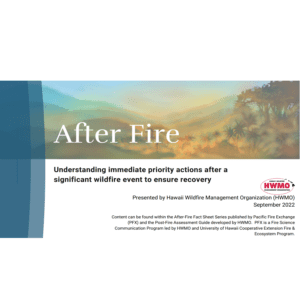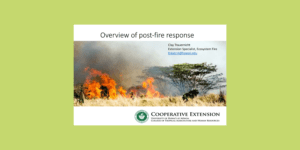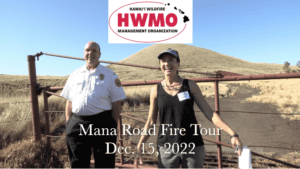Summary results of 30 plants recommended by experts for planting in Hawai`i from sea level to 2,000 ft elevation (2023 survey results)
Species list of 30 plants recommended by experts for planting in Hawai`i from sea level to 2,000 ft elevation (2023 survey results)
Dr. Kim Burnett, Assistant Director of the University of Hawai`i Economic Research Organization presents some of her economic analysis of Hawaiian dry forest restoration as well as wildfire-related work in the aftermath of the August 2023 Maui fires.
When re-planting, limit the spread of invasive pests by following these guidelines.
After fire, there are immediate actions you can take to ensure a recovery for the people first of all, soil and water conservation
As wildfire, drought and invasive species increasingly impact native ecosystems, plants and animals, our remaining natural and cultural Hawaiian heritage is more threatened than ever.
A slide presentation overview by Dr. Clay Trauernicht of best practices for assessing and mitigating after-fire impacts to the environment.
On December 13 -15, 2022 the Hawaiʻi Wildfire Management Organization and wildland fire managers from the western U.S. and Hawaiʻi’s county, state, and federal fire agencies met on Hawai‘i Island. Hawai‘i representatives were able to bring mainland partners up to speed on Hawai‘i’s fire ecology, our mitigation challenges, our collaborative programs to educate and mitigate, and our post-fire stabilization needs and recovery goals via a field tour of one of Hawai‘i’s largest fires in recent history.
Invasive grasses have spread across a quarter of Hawai‘i’s land, and they’re fueling an alarming rise in wildfires. Coalitions are fighting back with new urgency and old tools. By Cynthia Wessendorf
A look at the resiliency of a Hawaiian woodland forest within Hawai‘i Volcanoes National Park 25 years after fire.









